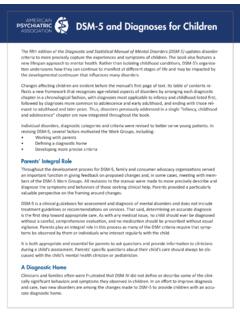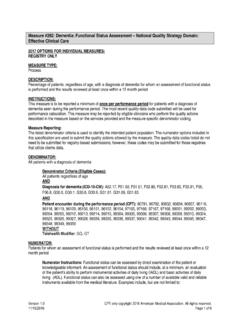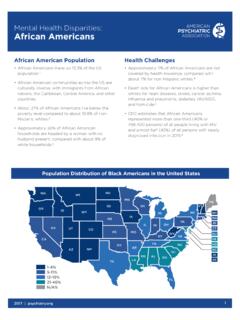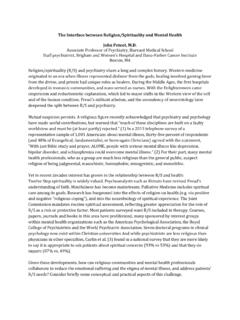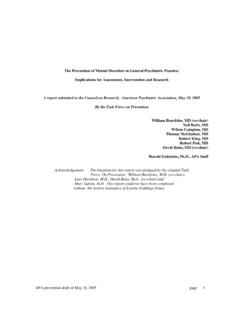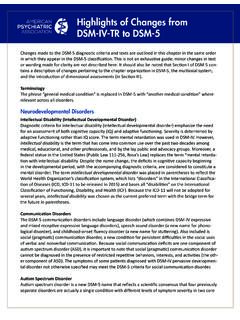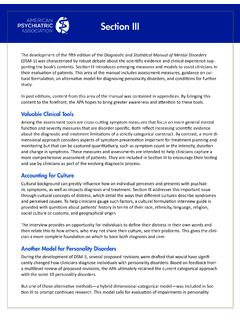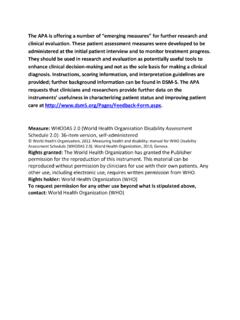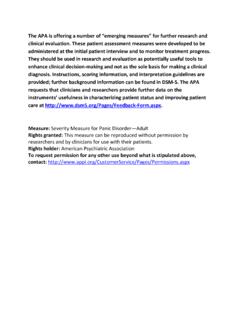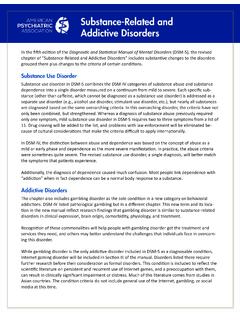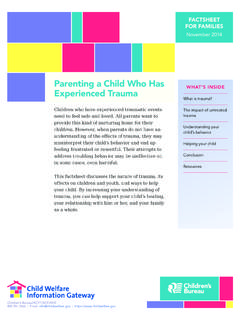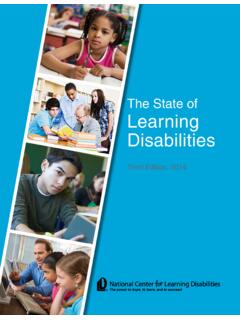Transcription of Mental Health Disparities: Hispanics and Latinos
1 Mental Health Disparities: Hispanics and LatinosHispanic and Latino PopulationThe Hispanic/Latino community is very diverse and includes people from many different nations and races. While many have lived in the for many generations, others are recent immigrants who may face inequities in socioeconomic status, education, and access to Health care services. There are many misconceptions and stereotypes about who is considered Latino, including the difference between the terms Latino and Hispanic. Hispanic: usually refers to language and those whose ancestry comes from Spain or Spanish-speaking countries. Latino: usually refers to geography and specifically, to Latin America which includes individuals from the Caribbean, South America, and Central of Hispanic/Latino PopulationSource: Pew Research Center, 201420 to 43%More than 35%10 to 19%Less than 10% More than of the population ( million) self-identify as Hispanic or Latino, making people of Hispanic origin the nation s largest racial/ethnic minority.
2 1 Population Distribution of Hispanics in the United States From 2015 to 2016, Hispanic population grew by 2% (up to million) in the By 2060, Hispanics are expected to make up 30% of the total population (129 million). 2 Hispanics are the youngest major racial/ethnic group in the : 1/3 of the nation s Hispanic population is younger than 18. 3 Approximately of Hispanics in the held a bachelor s degree or higher in 2016, compared with for non-Hispanic whites and for non-Hispanic blacks. Health Service Use in the Past Year amongAdults with Any Mental Illness, by orAfrican AmericanAmerican Indianor Alaska NativeHispanicAsianTwo or MoreRacesAny Mental Health Service UseSource: SAMHSA, 2013 Mental Health , Utilization of Services, and Disparities: Hispanics are at lower risk of most psychiatric disorders compared with non-Hispanic whites. 7 Hispanics report higher rates for most psychiatric disorders than Hispanic immigrants.
3 4 Studies have shown that older Hispanic adults and Hispanic youth are especially vulnerable to psychological stresses associated with immigration and acculturation. 5 Approximately 1 in 10 Hispanics with a Mental disorder use Mental Health services from a general Health care provider, while only 1 in 20 receive such services from a Mental Health specialist. 6 Hispanics are more likely to report poor communication with their Health provider. 5 Several studies have found that bilingual patients are evaluated differently when interviewed in English as opposed to Spanish and that Hispanics are more frequently undertreated. Nationally, of Hispanics are uninsured, compared with of White non-Hispanic , 8 Low rates of insurance coverage for Hispanic is likely to be a function of ethnicity, immigration status, and citizenship in Hispanic/Latino children and Adolescents Hispanic children and adolescents are at significant risk for Mental Health problems, and in many cases at greater risk than white Among Hispanic students in grades 9-12 in 2015: had seriously considered attempting suicide, had made a plan to attempt suicide, had attempted suicide, and had made a suicide attempt that resulted in an injury, poisoning, or overdose that required medical attention .
4 These rates were consistently higher in Hispanic students than in white and black students. 10 In 2014, Hispanic and white adolescents aged 12-17 in the were more likely than black or Asian adolescents to have initiated alcohol use or cigarette use in the past year. About 10% of white and Hispanic adolescents initiated alcohol use, compared with for blacks and for Asian. Approximately of Hispanic adolescents initiated cigarette use, compared Past Year Mental Health Treatment, by for white adolescents, for black adolescents, and for Asian adolescents. 11 Hispanic adolescents are half as likely than white adolescents to use antidepressants. 12 Hispanic children are half as likely as white children to use stimulants to treat disorders such as attention deficit /hyperactivity disorder (ADHD) and attention deficit disorder (ADD). 13 Barriers to Accessing Mental Health Care Lack of insurance or inadequate insurance Lack of knowledge/awareness about Mental Health problems and services available Cultural stigma associated with Mental illness Language Lack of culturally tailored services and culturally competent Mental Health professionals Shortage of bilingual or linguistically trained Mental Health professionals Difficulties recognizing incipient signs of Mental illness Problems identifying psychiatric symptoms when chief complaint is somatic symptom To learn about best practices for treating diverse populations and to get answers to your questions by leading psychiatrists, please visit APA's Cultural Competency webpage at Resources National Council of la Raza (NCLR) National Hispanic Medical Association American Society of Hispanic Psychiatry (ASHP) National Alliance for Hispanic Health (NAHH)
5 National Alliance on Mental Illness (NAMI) Mental Health America (MHA) League of United Latin American Citizens (LULAC) Department of Health and Human Services Office of Minority Health US Census. Facts for Features: Hispanic Heritage Month. 2016. features/2016 The Nation s Older Population Is Still Growing, Census Bureau Reports: June 22, 2017. Pew Research Center. Statistical Portrait of Hispanics in the United States. 2016. 4 Alegria M. et al, Prevalence of Mental illness in immigrant and non-immigrant Latino groups, Am J Psychiatry. 2008; 165(3): 359 369. 5 The League of United Latin American Citizens. Latino Health Disparities. US Office of the Surgeon General (US); Center for Mental Health Services (US); National Institute of Mental Health (US). Mental Health : Culture, Race, and Ethnicity: A Supplement to Mental Health : A Report of the Surgeon General. Rockville (MD): Substance Abuse and Mental Health Services Administration (US); 2001 Aug.
6 Chapter 6 Mental Health Care for Hispanic Americans Summary Health Statistics: National Health Interview Survey, 2015. 8 US Census. Health Insurance Coverage in the United States. 2015. 9 2015 National Survey on Drug Use and Health (NSDUH). 2016. 10 Kann L, et al. Youth Risk Behavior Surveillance United States, 2013. MMWR 2014; 63(ss04): 1-168. 11 Behavioral Health Barometer United States, 2015. 12 Kirby J, et al. Explaining racial and ethnic differences in antidepressant use among adolescents. Med Care Res Rev. 2010. 67(3):342-363. 13 Hudson J, et al. "Explaining racial and ethnic differences in children 's use of stimulant medication, "Medical Care. 2007. 45(11):1068-1075. resource was prepared by the Division of Diversity and Health Equity. Updated and reviewed, respectively, by Maria Jose Lisotto, , and the Council on Minority Mental Health and Health Disparities.
